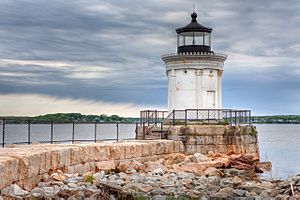Portland Breakwater Light facts for kids
 |
|
| Portland Breakwater Lighthouse after restoration | |
|
|
|
| Location | NE end of Portland Breakwater in Portland Harbor, South Portland, Maine |
|---|---|
| Coordinates | 43°39′19.872″N 70°14′5.471″W / 43.65552000°N 70.23485306°W |
| Year first constructed | 1855 |
| Year first lit | 1875 (current tower) |
| Automated | 1934 |
| Deactivated | 1942 |
| Foundation | Granite block caisson |
| Construction | Iron plate with brick lining |
| Tower shape | conical |
| Markings / pattern | resembles 4th century Greek monument |
| Focal height | |
| Original lens | Sixth order fresnel, 1855 |
| Characteristic | Flashing white 4 s |
| USCG number | 1-7699 |
The Portland Breakwater Light (also called Bug Light) is a small, unique lighthouse in South Portland, Maine. It's famous for looking like an ancient Greek monument! This special lighthouse helps guide boats safely in Portland Harbor.
Contents
The Story of Bug Light
The first lighthouse here was built in 1855. It was a simple wooden structure. Later, the "breakwater" (a wall built to protect the harbor) was made longer. Because of this, a new, stronger lighthouse was needed.
Building the New Lighthouse
In 1875, a brand new lighthouse was built. This one was made from curved cast-iron plates. To make it look fancy, six decorative Corinthian columns were added. These columns hid the seams where the iron plates joined together.
The design of Bug Light was inspired by an ancient Greek building. It looked like the Choragic Monument of Lysicrates in Athens, Greece. This monument was well-known from pictures and drawings. The architect who designed Bug Light was Thomas U. Walter. He was also famous for designing parts of the U.S. Capitol building in Washington, D.C.
Changes Over Time
For many years, there were wooden sheds and a six-room house for the lighthouse keeper. A keeper was the person who lived at the lighthouse and made sure its light was working.
In 1897, another lighthouse called Spring Point Ledge Light was built nearby. The houses around Bug Light were then taken down. The keepers from Spring Point Ledge Lighthouse took care of both lighthouses.
Bug Light During World War II
During World War II, big changes happened near Bug Light. The land around the breakwater was filled in. This was done so the New England Shipbuilding Corporation could build two shipyards right next to the lighthouse. These shipyards built many "Liberty Ships." These ships were very important for the war effort.
Because the breakwater was now much smaller due to the new land, the lighthouse wasn't as needed anymore. So, in 1943, Bug Light was "decommissioned." This means it was officially taken out of service and its light was turned off.
Bringing Bug Light Back to Life
After many years, Bug Light was fully restored in 1989. It looked beautiful again! Then, in 2002, its light was turned back on. Today, it helps guide boats as a "private aid to navigation." This means it's not a main lighthouse managed by the government, but it still helps boats find their way.
Visiting Bug Light Park
Today, you can visit Bug Light Park to see the lighthouse up close. The park also remembers the important shipbuilding work that happened there during World War II.
On June 19, 1973, Bug Light was added to the National Register of Historic Places. This is a list of important historical sites in the United States.
Gallery






